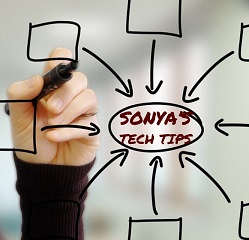
Ah the slide presentation. For some, it’s the best route to getting an audience involved with a talk/discussion/lecture, showing the audience what to focus on. But after awhile, it can become a bit… routine. If you fall back on the same old delivery, your audience will pick up on it and you may lose their attention. I personally, don’t believe that “death by PowerPoint” needs to be a thing.
Fortunately, there are a number of ways to enliven your presentations and turn them into effective tools that will not only help you get your point across, but also transform the event into an active and memorable moment.
Don’t believe me? Read on.
1: Do more with less
A presentation slide that is stuffed with data will lose your audience. Sometimes a single word is far more powerful than a paragraph. In some cases, a single image will go a long way toward communicating your point. The challenge here is in choosing the right word or image. It must be evocative and effectively convey the essence of meaning–a distilled version of a chapter heading for your presentation. Used sparingly and at the right moment, those single word or image slides will pack a punch.
2: Allow the moment to breathe
This may seem a bit esoteric, but people digesting your material need carefully planned moments to allow a meaning or important point to breathe. If you plow through text and don’t pause to give the text “breathing room,” the listener will tune out. This is especially true on important passages or points–a pause will allow the audience to take in the full meaning of your most crucial data.
3: Eliminate bullet point slides
This could be quite counter to popular thought, but bullet point slides are tiresome and boring. With the slightest bit of imagination, you can transform a bullet point slide into a more interactive piece. If you must use bullet point list, bring each point in with an animation, one at a time, as it serves you in your speech. Using this method, that list will help emphasize each piece of information. If you are doing your presentation in PowerPoint don’t forget the SmartArt tool that can make your bulleted items more attractive and interesting.
4: Punch up the soundscape
There is no reason why you shouldn’t use sound during your presentation. Everyone loves a good piece of music. Not only does music often have an emotional or memory tie-in for an audience, it will wake them up. Use bits of music, sound effects, a short video, or recorded voice at carefully timed places within your presentation. Just remember, if you do use music (or other audio bits), do not infringe on copyright law. There are plenty of places where you can get royalty-free music to use (such as this Royalty Free Music site).
5: Make use of your environment
Most presenters stand in what I call the “safe zone” and rarely, if ever, move outside that comfortable circle. This places a barrier between you and your audience, which removes all intimacy. If you want to really engage your audience, get up close and personal. Use what the room has to offer. Sit down on the edge of a stage, walk the aisles, place the listeners between you and the video… use your space. Another handy trick is to make sure you place enough distance between you and the slides so that the audience must look back and forth between the two. With this technique, the emphasis given by specific slides will be even greater.
6: Go with a sans serif font
You may be tempted to drop a really cool font into your presentation. (If you use Papyrus, you’ve already failed.) But those fancy fonts may make it difficult for your audience to read text from a distance. Sans serif fonts, such as Arial, Calibri, and Helvetica (this font) are much easier to ready from all distances and angles. You should also make sure all text is large enough for the person seated farthest from the stage to read clearly. Finally, make sure there is plenty of contrast between your background and text–do not place semi-transparent text (or dark text) on a busy background.
7: Speak with ease
One of the biggest mistakes presenters make is speaking too quickly. This happens for a reason: nerves. The second your nerves kick in, your rate of speech will increase significantly. You will not know this. Your presentation will seem to you as if it is going along at a perfect clip. But in reality, you’ll most likely be zipping along so quickly, the audience has no time to process what you’re saying. There is a trick to help you avoid this. When you practice your presentation, run through it much more slowly than you would normally. This, of course, doesn’t work when your slides are timed to your words (another pitfall–make them all manual). It is important to speak with a comfortable natural pace and rhythm.
8: Make use of pop culture references
Some may deem this unprofessional, but there are bits and pieces of pop culture that people readily and quickly cling to. Not only that, but those references will make your audience laugh–and laughter is your best friend. Whatever happens to be popular at the time, take advantage of it. If a particular meme is all the rage, don’t hesitate to give it a brief moment to shine in your presentation. The good thing about nearly every presentation ever given is that they are fleeting. You give your presentation and that’s it–chances are incredibly slim that you’ll be bringing that presentation back for an encore next year. With that in mind, you don’t have to worry about your slides becoming dated by memes that will have long faded from memory.
9: Warm up your voice before you begin
Did you know that the average human voice can speak only two to three hours before it is negatively affected by the limitations of exhaustion and overuse? That timeframe is even shorter if you jump right into a situation where you must speak loudly and clearly without first warming up the muscles used for speech (larynx, lips, vocal cords, jaw). That doesn’t mean you need to do vocalese scales with an accompanist. The best warmups you can do are humming and buzzing your lips up and down scales. With those warmed-up muscles, you can more easily use the full range of your voice. The last thing you want to do is deliver your presentation in a droll monotone.
10: Work with your smartphone or tablet
Don’t set yourself up to have to constantly rush back to your laptop to advance slides. There are plenty of ways to avoid this. If you’re up on technology, you can use an Android and Chromecast to cast your presentation to a large, high def television. Or you can scale it back a bit and use something like the LibreOffice Impress Remote app and control your presentation with your mobile device. Make yourself and your presentation relevant to modern technology and you’ll be more likely to have the attention of your audience.
11: Break it up
Break up a presentation with an interactive assignment, task, discussion, graphic organizer…..something that keeps the students engaged. After all, listening to anyone more than 20 minutes can be a drag.

